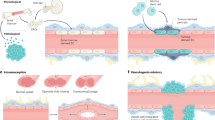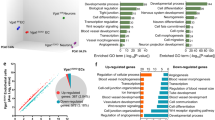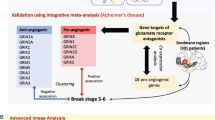Abstract
Angiogenesis — the growth of new blood vessels — is a crucial force for shaping the nervous system and protecting it from disease. Recent advances have improved our understanding of how the brain and other tissues grow new blood vessels under normal and pathological conditions. Angiogenesis factors, especially vascular endothelial growth factor, are now known to have roles in the birth of new neurons (neurogenesis), the prevention or mitigation of neuronal injury (neuroprotection), and the pathogenesis of stroke, Alzheimer's disease and motor neuron disease. As our understanding of pathophysiology grows, these developments may point the way towards new molecular and cell-based therapies.
This is a preview of subscription content, access via your institution
Access options
Subscribe to this journal
Receive 51 print issues and online access
$199.00 per year
only $3.90 per issue
Buy this article
- Purchase on Springer Link
- Instant access to full article PDF
Prices may be subject to local taxes which are calculated during checkout





Similar content being viewed by others
References
Beck, L. Jr & D'Amore, P. A. Vascular development: cellular and molecular regulation. FASEB J. 11, 365–373 (1997).
Risau, W. Mechanisms of angiogenesis. Nature 386, 671–674 (1997).
Ballabh, P., Braun, A. & Nedergaard, M. The blood–brain barrier: an overview: structure, regulation, and clinical implications. Neurobiol. Dis. 16, 1–13 (2004).
Keck, P. J. et al. Vascular permeability factor, an endothelial cell mitogen related to PDGF. Science 246, 1309–1312 (1989).
Leung, D. W., Cachianes, G., Kuang, W. -J., Goeddel, D. V. & Ferrara, N. Vascular endothelial growth factor is a secreted angiogenic mitogen. Science 246, 1306–1309 (1989).
Goldberg, M. A. & Schneider, T. J. Similarities between the oxygen-sensing mechanisms regulating the expression of vascular endothelial growth factor and erythropoietin. J. Biol. Chem. 269, 4355–4359 (1994).
Helton, R. et al. Brain-specific knock-out of hypoxia-inducible factor-1α reduces rather than increases hypoxic–ischemic damage. J. Neurosci. 25, 4099–4107 (2005).
Cross, M. J., Dixelius, J., Matsumoto, T. & Claesson-Welsh, L. VEGF-receptor signal transduction. Trends Biochem. Sci. 28, 488–494 (2003).
Ferrara, N., Gerber, H. P. & LeCouter, J. The biology of VEGF and its receptors. Nature Med. 9, 669–676 (2003).
Ment, L. R. et al. Vascular endothelial growth factor mediates reactive angiogenesis in the postnatal developing brain. Dev. Brain Res. 100, 52–61 (1997).
Krum, J. M. & Rosenstein, J. M. Patterns of angiogenesis in neural transplant models: II. Fetal neocortical transplants. J. Comp. Neurol. 271, 331–345 (1988).
Broadwell, R. D. et al. Angiogenesis and the blood–brain barrier in solid and dissociated cell grafts within the CNS. Prog. Brain Res. 82, 95–101 (1990).
Geny, C. et al. Long-term delayed vascularization of human neural transplants to the rat brain. J. Neurosci. 14, 7553–7562 (1994).
Plate, K. H., Breier, G., Weich, H. A. & Risau, W. Vascular endothelial growth factor is a potential tumour angiogenesis factor in human gliomas in vivo. Nature 359, 845–848 (1992).
Kim, K. J. et al. Inhibition of vascular endothelial growth factor-induced angiogenesis suppresses tumour growth in vivo. Nature 362, 841–844 (1993).
Weis, S. M. & Cheresh, D. A. Pathophysiological consequences of VEGF-induced vascular permeability. Nature 437, 497–504 (2005).
Ellerby, H. M. et al. Anti-cancer activity of targeted pro-apoptotic peptides. Nature Med. 5, 1032–1038 (1999).
Dirnagl, U., Simon, R. P. & Hallenbeck, J. M. Ischemic tolerance and endogenous neuroprotection. Trends Neurosci. 26, 248–254 (2003).
Krupinski, J., Kaluza, J., Kumar, P., Kumar, S. & Wang, J. M. Role of angiogenesis in patients with cerebral ischemic stroke. Stroke 25, 1794–1798 (1994).
Chen, H. H., Chien, C. -H. & Liu, H. M. Correlation between angiogenesis and basic fibroblast growth factor expression in experimental brain infarct. Stroke 25, 1651–1657 (1994).
Zhang, Z. G. et al. VEGF enhances angiogenesis and promotes blood–brain barrier leakage in the ischemic brain. J. Clin. Invest. 106, 829–838 (2000).
van Bruggen, N. et al. VEGF antagonism reduces edema formation and tissue damage after ischemia/reperfusion injury in the mouse brain. J. Clin. Invest. 104, 1613–1620 (1999).
Thurston, G. et al. Angiopoietin-1 protects the adult vasculature against plasma leakage. Nature Med. 6, 460–463 (2000).
Sharp, F. R. & Bernaudin, M. HIF1 and oxygen sensing in the brain. Nature Rev. Neurosci. 5, 437–448 (2004).
Marchuk, D. A., Srinivasan, S., Squire, T. L. & Zawistowski, J. S. Vascular morphogenesis: tales of two syndromes. Hum. Mol. Genet. 12 Spec. No. 1, R97–R112 (2003).
Zhu, Y. et al. Hypoxic induction of endoglin via mitogen-activated protein kinases in mouse brain microvascular endothelial cells. Stroke 34, 2483–2488 (2003).
Abrous, D. N., Koehl, M. & Le Moal, M. Adult neurogenesis: from precursors to network and physiology. Physiol. Rev. 85, 523–569 (2005).
Sanai, N. et al. Unique astrocyte ribbon in adult human brain contains neural stem cells but lacks chain migration. Nature 427, 740–744 (2004).
van Praag, H. et al. Functional neurogenesis in the adult hippocampus. Nature 415, 1030–1034 (2002).
Shors, T. J. et al. Neurogenesis in the adult is involved in the formation of trace memories. Nature 410, 372–376 (2001).
Parent, J. M. et al. Dentate granule cell neurogenesis is increased by seizures and contributes to aberrant network reorganization in the adult rat hippocampus. J. Neurosci. 17, 3727–3738 (1997).
Scharfman, H. E., Goodman, J. H. & Sollas, A. L. Granule-like neurons at the hilar/CA3 border after status epilepticus and their synchrony with area CA3 pyramidal cells: functional implications of seizure-induced neurogenesis. J. Neurosci. 20, 6144–6158 (2000).
Liu, J., Solway, K., Messing, R. O. & Sharp, F. R. Increased neurogenesis in the dentate gyrus after transient global ischemia in gerbils. J. Neurosci. 18, 7768–7778 (1998).
Gu, W., Brannstrom, T. & Wester, P. Cortical neurogenesis in adult rats after reversible photothrombotic stroke. J. Cereb. Blood Flow Metab. 20, 1166–1173 (2000).
Jin, K. et al. Neurogenesis in dentate subgranular zone and rostral subventricular zone after focal cerebral ischemia in the rat. Proc. Natl Acad. Sci. USA 98, 4710–4715 (2001).
Parent, J. M., Valentin, V. V. & Lowenstein, D. H. Prolonged seizures increase proliferating neuroblasts in the adult rat subventricular zone–olfactory bulb pathway. J. Neurosci. 22, 3174–3188 (2002).
Arvidsson, A., Collin, T., Kirik, D., Kokaia, Z. & Lindvall, O. Neuronal replacement from endogenous precursors in the adult brain after stroke. Nature Med. 8, 963–970 (2002).
Nakatomi, H. et al. Regeneration of hippocampal pyramidal neurons after ischemic brain injury by recruitment of endogenous neural progenitors. Cell 110, 429–441 (2002).
Parent, J. M., Vexler, Z. S., Gong, C., Derugin, N. & Ferriero, D. M. Rat forebrain neurogenesis and striatal neuron replacement after focal stroke. Ann. Neurol. 52, 802–813 (2002).
Jin, K. et al. Directed migration of neuronal precursors into the ischemic cerebral cortex and striatum. Mol. Cell. Neurosci. 24, 171–189 (2003).
Curtis, M. A. et al. Increased cell proliferation and neurogenesis in the adult human Huntington's disease brain. Proc. Natl Acad. Sci. USA 100, 9023–9027 (2003).
Jin, K. et al. Increased hippocampal neurogenesis in Alzheimer's disease. Proc. Natl Acad. Sci. USA 101, 343–347 (2004).
Jin, K. et al. Enhanced neurogenesis in Alzheimer's disease transgenic (PDGF-APPSw,Ind) mice. Proc. Natl Acad. Sci. USA 101, 13363–13367 (2004).
Jin, K. et al. Fibroblast growth factor-2 promotes neurogenesis and neuroprotection and prolongs survival in a transgenic mouse model of Huntington disease. Proc. Natl Acad. Sci. USA 102, 18189–18194 (2005).
Fallon, J. et al. In vivo induction of massive proliferation, directed migration, and differentiation of neural cells in the adult mammalian brain. Proc. Natl Acad. Sci. USA 97, 14686–14691 (2000).
Zhao, M. et al. Evidence for neurogenesis in the adult mammalian substantia nigra. Proc. Natl Acad. Sci. USA 100, 7925–7930 (2003).
Chi, L. et al. Motor neuron degeneration promotes neural progenitor cell proliferation, migration and neurogenesis in the spinal cords of ALS mice. Stem Cells published online 11 August 2005; doi:10.1634/stemcells.2005–0076 (2005).
Jin, K. et al. Vascular endothelial growth factor (VEGF) stimulates neurogenesis in vitro and in vivo. Proc. Natl Acad. Sci. USA 99, 11946–11950 (2002).
Schanzer, A. et al. Direct stimulation of adult neural stem cells in vitro and neurogenesis in vivo by vascular endothelial growth factor. Brain Pathol. 14, 237–248 (2004).
Mani, N., Khaibullina, A., Krum, J. M. & Rosenstein, J. M. Astrocyte growth effects of vascular endothelial growth factor (VEGF) application to perinatal neocortical explants: receptor mediation and signal transduction pathways. Exp. Neurol. 192, 394–406 (2005).
Jin, K. et al. Cerebral neurogenesis is induced by intranasal administration of growth factors. Ann. Neurol. 53, 405–409 (2003).
Cao, L. et al. VEGF links hippocampal activity with neurogenesis, learning and memory. Nature Genet. 36, 827–835 (2004).
Schofield, R. The relationship between the spleen colony-forming cell and the haemopoietic stem cell. Blood Cells 4, 7–25 (1978).
Palmer, T. D., Willhoite, A. R. & Gage, F. H. Vascular niche for adult hippocampal neurogenesis. J. Comp Neurol. 425, 479–494 (2000).
Louissaint, A., Rao, S., Leventhal, C. & Goldman, S. A. Coordinated interaction of neurogenesis and angiogenesis in the adult songbird brain. Neuron 34, 945–960 (2002).
Shen, Q. et al. Endothelial cells stimulate self-renewal and expand neurogenesis of neural stem cells. Science 304, 1338–1340 (2004).
Mukouyama, Y. S., Gerber, H. P., Ferrara, N., Gu, C. & Anderson, D. J. Peripheral nerve-derived VEGF promotes arterial differentiation via neuropilin 1-mediated positive feedback. Development 132, 941–952 (2005).
Carmeliet, P. & Tessier-Lavigne, M. Common mechanisms of nerve and blood vessel wiring. Nature 436, 193–200 (2005).
Haigh, J. J. et al. Cortical and retinal defects caused by dosage-dependent reductions in VEGF-A paracrine signaling. Dev. Biol. 262, 225–241 (2003).
Sondell, M., Lundborg, G. & Kanje, M. Vascular endothelial growth factor has neurotrophic activity and stimulates axonal outgrowth, enhancing cell survival and Schwann cell proliferation in the peripheral nervous system. J. Neurosci. 19, 5731–5740 (1999).
Silverman, W. F., Krum, J. M., Mani, N. & Rosenstein, J. M. Vascular, glial and neuronal effects of vascular endothelial growth factor in mesencephalic explant cultures. Neuroscience 90, 1529–1541 (1999).
Rosenstein, J. M., Mani, N., Khaibullina, A. & Krum, J. M. Neurotrophic effects of vascular endothelial growth factor on organotypic cortical explants and primary cortical neurons. J. Neurosci. 23, 11036–11044 (2003).
Khaibullina, A. A., Rosenstein, J. M. & Krum, J. M. Vascular endothelial growth factor promotes neurite maturation in primary CNS neuronal cultures. Dev. Brain Res. 148, 59–68 (2004).
Jin, K. L. et al. Vascular endothelial growth factor stimulates neurite outgrowth from cerebral cortical neurons via rho kinase signalling. J. Neurobiol. (in the press).
Jin, K. L., Mao, X. O. & Greenberg, D. A. Vascular endothelial growth factor rescues HN33 neural cells from death induced by serum withdrawal. J. Mol. Neurosci. 14, 197–203 (2000).
Jin, K. L., Mao, X. O. & Greenberg, D. A. Vascular endothelial growth factor: direct neuroprotective effect in in vitro ischemia. Proc. Natl Acad. Sci. USA 97, 10242–10247 (2000).
Jin, K. et al. Caspase-3 and the regulation of hypoxic neuronal death by vascular endothelial growth factor. Neuroscience 108, 351–358 (2001).
Matsuzaki, H. et al. Vascular endothelial growth factor rescues hippocampal neurons from glutamate-induced toxicity: signal transduction cascades. FASEB J. 15, 1218–1220 (2001).
Svensson, B. et al. Vascular endothelial growth factor protects cultured rat hippocampal neurons against hypoxic injury via an antiexcitotoxic, caspase-independent mechanism. J. Cereb. Blood Flow Metab. 22, 1170–1175 (2002).
Kovacs, Z., Ikezaki, K., Samoto, K., Inamura, T. & Fukui, M. VEGF and Flt: expression time kinetics in rat brain infarct. Stroke 27, 1865–1873 (1996).
Hayashi, T., Abe, K., Suzuki, H. & Itomaya, Y. Rapid induction of vascular endothelial growth factor gene expression after transient middle cerebral artery occlusion in rats. Stroke 28, 2039–2044 (1997).
Lennmyr, F., Ata, K. A., Funa, K., Olsson, Y. & Terent, A. Expression of vascular endothelial growth factor (VEGF) and its receptors (Flt-1 and Flk-1) following permanent and transient occlusion of the middle cerebral artery in the rat. J. Neuropathol. Exp. Neurol. 57, 874–882 (1998).
Plate, K. H., Beck, H., Danner, S., Allegrini, P. R. & Wiessner, C. Cell type specific upregulation of vascular endothelial growth factor in an MCA-occlusion model of cerebral infarct. J. Neuropathol. Exp. Neurol. 58, 654–666 (1999).
Rosenstein, J. M., Mani, N., Silverman, W. F. & Krum, J. M. Patterns of brain angiogenesis after vascular endothelial growth factor administration in vitro and in vivo. Proc. Natl Acad. Sci. USA 95, 7086–7091 (1998).
Krum, J. M., Mani, N. & Rosenstein, J. M. Angiogenic and astroglial responses to vascular endothelial growth factor administration in adult rat brain. Neuroscience 110, 589–604 (2002).
Hayashi, T., Abe, K. & Itoyama, Y. Reduction of ischemic damage by application of vascular endothelial growth factor in rat brain after transient ischemia. J. Cereb. Blood Flow Metab. 18, 887–895 (1998).
Bao, W. L., Lu, S. D., Wang, H. & Sun, F. Y. Intraventricular vascular endothelial growth factor antibody increases infarct volume following transient cerebral ischemia. Chung Kuo Yao Li Hsueh Pao 20, 313–318 (1999).
Sun, Y. et al. VEGF-induced neuroprotection, neurogenesis, and angiogenesis after focal cerebral ischemia. J. Clin. Invest. 111, 1843–1851 (2003).
Sun, Y. et al. Increased severity of cerebral ischemic injury in vascular endothelial growth factor-B (VegfB)-deficient mice. J. Cereb. Blood Flow Metab. 24, 1146–1152 (2004).
Kalaria, R. N. et al. Vascular endothelial growth factor in Alzheimer's disease and experimental cerebral ischemia. Brain Res. Mol. Brain Res. 62, 101–105 (1998).
Del Bo, R. et al. Vascular endothelial growth factor gene variability is associated with increased risk for AD. Ann. Neurol. 57, 373–380 (2005).
Schratzberger, P. et al. Reversal of experimental diabetic neuropathy by VEGF gene transfer. J. Clin. Invest. 107, 1083–1092 (2001).
Schratzberger, P. et al. Favorable effect of VEGF gene transfer on ischemic peripheral neuropathy. Nature Med. 6, 405–413 (2000).
Chattopadhyay, M. et al. HSV-mediated gene transfer of vascular endothelial growth factor to dorsal root ganglia prevents diabetic neuropathy. Gene Therapy 12, published online 21 April 2005; doi:10.1038/sj.gt.3302533 (2005).
Eig, J. Luckiest Man: The Life and Death of Lou Gehrig (Simon & Schuster, New York, 2005).
Rosen, D. R. et al. Mutations in Cu/Zn superoxide dismutase gene are associated with familial amyotrophic lateral sclerosis. Nature 362, 59–62 (1993).
Hadano, S. et al. A gene encoding a putative GTPase regulator is mutated in familial amyotrophic lateral sclerosis 2. Nature Genet. 29, 166–173 (2001).
Yang, Y. et al. The gene encoding alsin, a protein with three guanine-nucleotide exchange factor domains, is mutated in a form of recessive amyotrophic lateral sclerosis. Nature Genet. 29, 160–165 (2001).
Chen, Y. Z. et al. DNA/RNA helicase gene mutations in a form of juvenile amyotrophic lateral sclerosis (ALS4). Am. J. Hum. Genet. 74, 1128–1135 (2004).
Nishimura, A. L. et al. A mutation in the vesicle-trafficking protein VAPB causes late-onset spinal muscular atrophy and amyotrophic lateral sclerosis. Am. J. Hum. Genet. 75, 822–831 (2004).
Oosthuyse, B. et al. Deletion of the hypoxia-response element in the vascular endothelial growth factor promoter causes motor neuron degeneration. Nature Genet. 28, 131–138 (2001).
Lambrechts, D. et al. VEGF is a modifier of amyotrophic lateral sclerosis in mice and humans and protects motoneurons against ischemic death. Nature Genet. 34, 383–394 (2003).
Zheng, C., Nennesmo, I., Fadeel, B. & Henter, J. I. Vascular endothelial growth factor prolongs survival in a transgenic mouse model of ALS. Ann. Neurol. 56, 564–567 (2004).
Storkebaum, E. et al. Treatment of motoneuron degeneration by intracerebroventricular delivery of VEGF in a rat model of ALS. Nature Neurosci. 8, 85–92 (2005).
Azzouz, M. et al. VEGF delivery with retrogradely transported lentivector prolongs survival in a mouse ALS model. Nature 429, 413–417 (2004).
La Spada, A. R., Wilson, E. M., Lubahn, D. B., Harding, A. E. & Fischbeck, K. H. Androgen receptor gene mutations in X-linked spinal and bulbar muscular atrophy. Nature 352, 77–79 (1991).
Sopher, B. L. et al. Androgen receptor YAC transgenic mice recapitulate SBMA motor neuronopathy and implicate VEGF164 in the motor neuron degeneration. Neuron 41, 687–699 (2004).
Hillen, T. et al. Cause of stroke recurrence is multifactorial: patterns, risk factors, and outcomes of stroke recurrence in the South London Stroke Register. Stroke 34, 1457–1463 (2003).
Raber, J. et al. Irradiation attenuates neurogenesis and exacerbates ischemia-induced deficits. Ann. Neurol. 55, 381–389 (2004).
Acknowledgements
This work was supported by NIH grants NS44921 (D.A.G.) and AG21980 (K.J.) and by the Buck Institute for Age Research.
Author information
Authors and Affiliations
Corresponding author
Ethics declarations
Competing interests
The authors declare no competing financial interests.
Additional information
Author Information Reprints and permissions information is available at npg.nature.com/reprintsandpermissions.
Rights and permissions
About this article
Cite this article
Greenberg, D., Jin, K. From angiogenesis to neuropathology. Nature 438, 954–959 (2005). https://doi.org/10.1038/nature04481
Published:
Issue Date:
DOI: https://doi.org/10.1038/nature04481
This article is cited by
-
Multimodal evaluation of the effects of low-intensity ultrasound on cerebral blood flow after traumatic brain injury in mice
BMC Neuroscience (2024)
-
Hepatocyte growth factor-modified hair follicle stem cells ameliorate cerebral ischemia/reperfusion injury in rats
Stem Cell Research & Therapy (2023)
-
Angiogenesis after ischemic stroke
Acta Pharmacologica Sinica (2023)
-
Dl-3-n-butylphthalide promotes angiogenesis in ischemic stroke mice through upregulating autocrine and paracrine sonic hedgehog
Acta Pharmacologica Sinica (2023)
-
Molecular and genetic mechanisms in brain arteriovenous malformations: new insights and future perspectives
Neurosurgical Review (2022)
Comments
By submitting a comment you agree to abide by our Terms and Community Guidelines. If you find something abusive or that does not comply with our terms or guidelines please flag it as inappropriate.



